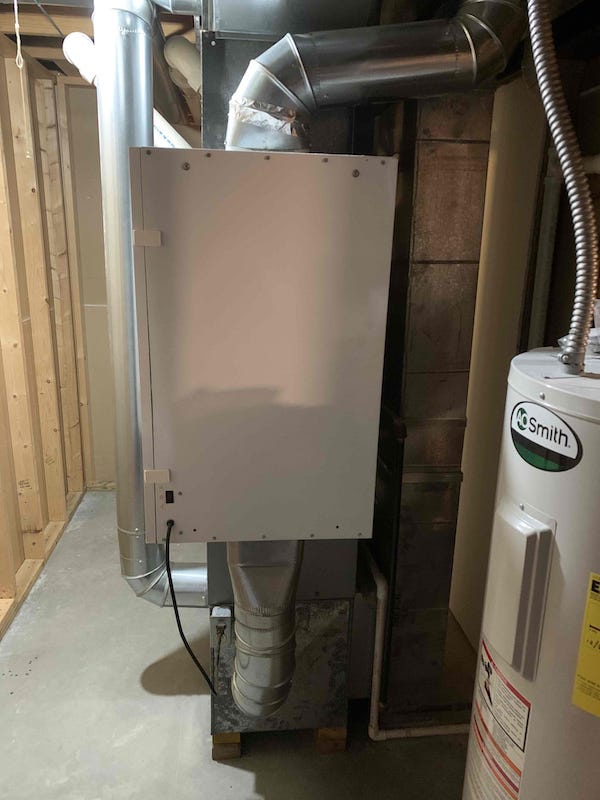One Integrated System Provides Cooling & Heating in Most Homes

There’s a reason that the phrase “heating and cooling system” is usually singular. Rather than two “systems,” most residential HVAC systems’ heating and cooling functions are combined in one integrated system. While not all of the components are shared between heating and cooling, some essential components do work all year to keep your home comfortable. This article will explore how various components of a typical residential HVAC system work together.
Your Heating System
Most American homes are heated and cooled by a central forced-air HVAC system. In such a system, heat is most commonly provided either by a combustion furnace (fueled usually by natural gas but in some homes by fuel oil or propane) or an electric air-source heat pump. Air is sucked into the furnace by a strong blower fan, then heated by flames sparked by the ignition of natural gas or other fuel, emerging from one or more burners. Next, the heated air is blown through a network of ducts installed throughout the home, emerging through vents and registers in every room. As part of the same process, air is pulled through return registers and ducts, and routed back to the furnace to be reheated. The air passes through an air filter before re-entering the furnace. In some homes, whole-house humidity control or enhanced air filtration are also part of this process.
An electric heat pump also uses a blower fan, ductwork system and air filter inside the house. However, it heats household air in a different way. Employing electric power, coolant (aka refrigerant) and heat-exchange coils, a heat pump extracts heat energy from outside the house and then releases it inside to heat a residence. There’s more to the process than that, but those are the basics.
Your Cooling System
Homes that are heated by a combustion furnace typically will have an air conditioning system that uses the furnace’s blower to pull air across heat-exchange coils and circulate cooled air throughout the house (as well as bring spent air back to the AC equipment). The inside component of a common split-system air conditioning system is usually located within the furnace housing. It consists of an evaporator coil and condensation drainage system, and works in tandem with an outside unit that contains a condenser coil, compressor and fan). During the cooling season, refrigerant in the evaporator coil extracts heat energy from interior air then sends that heat outside to be expelled via the condenser coil and fan. It’s able to perform this function due to refrigerant’s unique capability to easily transition between a liquid and gas.
An electric heat pump cools the home in the same way that an air conditioner does. The only difference is that it has its own air handler unit inside, rather than using a furnace blower to circulate air. When the cooling season changes to the heating season, the heat pump reverses its functions, and the inside evaporator coil becomes the condensing coil, and vice versa for outside.
How They Work Together
As you can see, an integrated heating and cooling system has discrete components for each function along with shared components for both. The shared components include the blower motor (in a furnace/AC system), ductwork, vents and registers, air filter and thermostat. For effective and energy-efficient cooling and heating, regular professional maintenance is strongly recommended, usually once a year for cooling and once a year for heating. Homeowner maintenance is also advised, which usually means regular air filter inspection and replacement, and keeping vents and registers from being blocked.
The air circulation/duct system works nearly year-round to keep your home comfortable, and consequently should be a part of any comprehensive professional maintenance regimen.
Don’t Forget the Thermostat
In any heating and cooling system, whether forced air or some other technology, a thermostat is mandatory – a device that regulates temperatures according to your preferences. Increasingly, high-tech programmable thermostats, some with WiFi capabilities, are used in residential settings.
Energy Efficiency Also Is Important
Another aspect of a smooth-operating central heating and cooling system is effective home weatherization. The outer envelope of the home should be tightly sealed, including windows and doors. In addition, the prescribed types and amounts of insulation should be placed at appropriate locations around the house, including walls, ceilings, attic, basement and ductwork (in parts of the house that don’t receive conditioned air).
An energy-efficient home not only saves on utility bills; it provides more comfortable and effective heating and cooling, and does so without unduly harming the environment.
